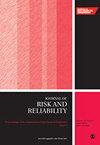A hybrid maintenance policy with fixed periodic structure and opportunistic replacement
IF 1.8
4区 工程技术
Q3 ENGINEERING, INDUSTRIAL
Proceedings of the Institution of Mechanical Engineers Part O-Journal of Risk and Reliability
Pub Date : 2023-06-01
DOI:10.1177/1748006X221100365
引用次数: 1
Abstract
We model a maintenance policy with fixed periodic structure that is a hybrid of periodic inspection and opportunistic replacement. The policy is applicable to geographically remote systems such as offshore wind farms. The policy has three phases. Initially, there is an inspection phase to identify early defects. This is followed by a wear out phase during which corrective replacements are performed. Preventive replacement occurs at the end of this phase. The novelty of the model is an opportunistic phase, which overlaps with the latter part of the corrective phase, when preventive replacement is executed early if an opportunity arises. In this way, we model the reality in which remote systems with high logistics costs and restricted access may benefit from opportunistic visits for maintenance. Using a numerical example, we analyse the behaviour of the decision variables for a range of values of the parameters common to such systems. These parameters relate to: component heterogeneity; restricted access; default (failure to execute a planned action); arrival of opportunities and other standard parameters in a maintenance cost model. Specifically, our results indicate when opportunities can have a significant impact on the cost-rate of the optimum policy, but that leveraging opportunities cannot achieve a very high availability. Generally, we demonstrate that maintenance planning should be flexible when factors beyond the control of the maintainer impact maintenance effectiveness.具有固定周期结构和机会替换的混合维护策略
我们建立了一个固定周期结构的维护策略模型,它是定期检查和机会替换的混合结构。该政策适用于地理位置偏远的系统,如海上风力发电场。该政策分为三个阶段。最初,有一个检查阶段来识别早期缺陷。接下来是磨损阶段,在此期间进行矫正更换。预防性替换发生在这一阶段的末尾。模型的新颖性是一个机会主义阶段,它与纠正阶段的后一部分重叠,当机会出现时,预防性更换会尽早执行。通过这种方式,我们模拟了具有高物流成本和受限访问权限的远程系统可能从维护的机会访问中受益的现实。通过一个数值例子,我们分析了决策变量对这类系统的共同参数取值范围的行为。这些参数涉及:组件异质性;限制访问;默认(未能执行计划的操作);维修成本模型中机会和其他标准参数的到来。具体地说,我们的结果表明机会何时会对最优策略的成本率产生重大影响,但是利用机会并不能获得非常高的可用性。一般来说,我们证明了当维护人员无法控制的因素影响维护有效性时,维护计划应该是灵活的。
本文章由计算机程序翻译,如有差异,请以英文原文为准。
求助全文
约1分钟内获得全文
求助全文
来源期刊

Proceedings of the Institution of Mechanical Engineers Part O-Journal of Risk and Reliability
ENGINEERING, MULTIDISCIPLINARY-ENGINEERING, INDUSTRIAL
CiteScore
4.50
自引率
19.00%
发文量
81
审稿时长
6-12 weeks
期刊介绍:
The Journal of Risk and Reliability is for researchers and practitioners who are involved in the field of risk analysis and reliability engineering. The remit of the Journal covers concepts, theories, principles, approaches, methods and models for the proper understanding, assessment, characterisation and management of the risk and reliability of engineering systems. The journal welcomes papers which are based on mathematical and probabilistic analysis, simulation and/or optimisation, as well as works highlighting conceptual and managerial issues. Papers that provide perspectives on current practices and methods, and how to improve these, are also welcome
 求助内容:
求助内容: 应助结果提醒方式:
应助结果提醒方式:


